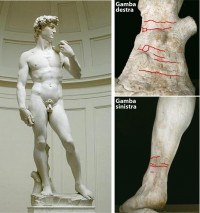 The Chianti region of Tuscany has experienced more than 250 tremors in three days, the two strongest of which measured 3.8. and 4.1 on the Richter scale. They only visible harm they caused was some minor structural damage in a town 20 miles south of Florence, but authorities are concerned that this could presage a larger seismic event that would wreak havoc on the city’s greatest artistic icon: Michelangelo’s statue of David.
The Chianti region of Tuscany has experienced more than 250 tremors in three days, the two strongest of which measured 3.8. and 4.1 on the Richter scale. They only visible harm they caused was some minor structural damage in a town 20 miles south of Florence, but authorities are concerned that this could presage a larger seismic event that would wreak havoc on the city’s greatest artistic icon: Michelangelo’s statue of David.
A study published in the Journal of Cultural Heritage last March found that David‘s ankles and the tree stump support behind the right leg were severely weakened by microfractures. Centrifuge tests on small gypsum models of the statue revealed that under stress, the statue could collapse forward, snapping at both ankles. Vibrations from nearby construction, maintenance in the building and certainly an earthquake would be sufficient to cause catastrophic damage to the monumental sculpture. Its own six-ton weight could be sufficient to bring David down.
 Small cracks in the left ankle and stump were first noticed in 1851. They may have developed during the flood of 1844 or three years later when sculptor Clemente Papi made a full-size plaster cast of David, but the recent study suggests the original source of the problem was that the statue spent almost four centuries outside the Palazzo della Signoria leaning forward at an approximately five degree angle which put undue stress on the weakest parts of the structure. (The angled placement wasn’t deliberate; researchers believe it was likely the result of the ground settling unevenly underneath the plinth.) The tilt was only corrected when David was moved indoors to the Galleria dell’Accademia in 1873.
Small cracks in the left ankle and stump were first noticed in 1851. They may have developed during the flood of 1844 or three years later when sculptor Clemente Papi made a full-size plaster cast of David, but the recent study suggests the original source of the problem was that the statue spent almost four centuries outside the Palazzo della Signoria leaning forward at an approximately five degree angle which put undue stress on the weakest parts of the structure. (The angled placement wasn’t deliberate; researchers believe it was likely the result of the ground settling unevenly underneath the plinth.) The tilt was only corrected when David was moved indoors to the Galleria dell’Accademia in 1873.
The microfractures have been monitored assiduously since 2001 and there doesn’t appear to have been any change in them, but even if the cracks aren’t getting gradually worse, they’re dangerous enough as it is. Add to that the inherent weakness of the marble — this particular block is riddled with microscopic holes that make it particularly susceptible to deterioration — and the giant-slayer is at constant risk. A few years ago there was discussion of insulating the statue from vibrations caused by footsteps of the thousands of tourists who walk by him every day.
The museum authorities declared that David would be safe even if the city was struck by an earthquake as strong as 5.5 magnitude, and there’s never been more than a 5.4 magnitude earthquake in Florence. That’s not much reassurance, however, because a) they can’t say for sure how strong the earthquake has to be to topple the statue, and b) just because a bigger one hasn’t hit yet doesn’t mean it won’t in the future.
Thankfully this weekend’s tremors have lit a fire under key asses. Culture Minister Dario Franceschini announced that the state would fund the construction of an anti-seismic plinth to the tune of 200,000 euros ($245,000). An anti-seismic platform has already been designed to fit David‘s needs and it was discussed as a possible solution to the microfracture danger when the study made the news earlier this year, but it was all just talk at that point. The past three days of seismic activity have finally spurred action.